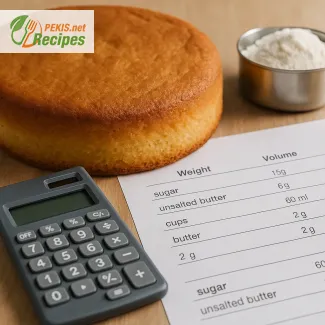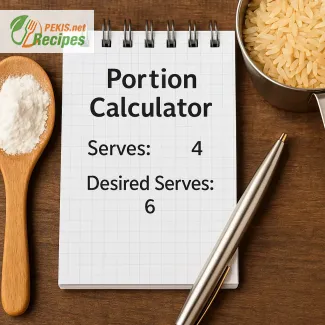
Discover the Delicate Art of Preparing Homemade Kadayif Noodles
A traditional treat with layers of texture and Mediterranean charm
Few culinary creations manage to bridge tradition and innovation the way Kadayif Noodles do. These finely shredded pastry threads, often referred to as Kataifi pastry, are the delicate backbone of some of the Middle East and Mediterranean’s most treasured desserts and savory dishes. Whether crisped into golden nests soaked in sweet syrup or layered into rich, nut-stuffed masterpieces, Kadayif brings an unmistakable texture and charm that delights from the first bite.
The beauty of homemade Kadayif Noodles lies not only in their ethereal texture but also in their cultural depth. This pastry dough, made from a simple mixture of water and flour, is skillfully spun into hair-thin strands and dried to perfection. It's this unique form that sets it apart from other doughs like phyllo or puff pastry. Kadayif is not rolled or kneaded—it’s poured in motion, allowing gravity and technique to create its signature threads. The process requires precision, but the result is nothing short of magical.
In Turkish, Arabic, Greek, and Balkan kitchens, Kadayif is more than just an ingredient—it’s a culinary ritual. Whether it’s used in Turkish Künefe, where the noodles are layered with soft cheese and soaked in orange blossom syrup, or in Greek Kataifi, filled with walnuts and spices, these delicate noodles play a starring role. But what makes homemade Kadayif truly special is the ability to control the texture and freshness—something rarely matched by store-bought versions.
Preparing Kadayif Noodles from scratch offers the opportunity to engage with a centuries-old tradition. You’ll connect with techniques passed down through generations, from street vendors in Istanbul to family kitchens in Athens. While making them at home might sound daunting, with the right tools and a bit of patience, the process becomes not only achievable but deeply satisfying.
The homemade version also opens the door to culinary creativity. Want to infuse your noodles with a subtle note of rose water or add a hint of citrus zest to the syrup? With homemade Kadayif, you’re in control of every detail. You can adjust thickness, crispiness, and shape to suit your recipe—whether crafting bite-sized dessert cups, forming layers in a tray bake, or even wrapping around savory fillings like spiced minced lamb or herbed cheeses.
Beyond their irresistible taste and texture, Kadayif Noodles evoke a sense of occasion. They're rarely used for everyday cooking, instead reserved for celebrations, holidays, and meaningful gatherings. In many cultures, preparing and serving a Kadayif dessert is a way to honor tradition and express hospitality. Their golden crispness, aromatic syrup, and nutty fillings create a multisensory experience that leaves a lasting impression.
As interest in Middle Eastern and Mediterranean cuisine continues to grow, more cooks are discovering the joy of making traditional components at home. With this recipe, you’ll learn how to create your own Kadayif Noodles with just a few ingredients and some careful technique. Once mastered, you’ll never look at store-bought Kataifi the same way again.
Whether you're preparing a festive dessert or crafting a modern twist on a savory pastry, Kadayif Noodles are your gateway to something truly special. From texture to flavor, their versatility allows you to elevate dishes with a unique touch that’s both ancient and contemporary. Embrace the process, enjoy the aroma of gently baking pastry, and let your creativity guide you. This is more than a recipe—it’s a celebration of culinary heritage.
Ready to learn how to make these delicate strands at home? In the following section, we’ll walk you through a step-by-step process to craft authentic Kadayif Noodles from scratch—thin, crisp, and perfect for every sweet or savory creation.
Step 1 – Make the batter:
In a mixing bowl, combine water (250 ml) and salt (1 g). Slowly sift in the all-purpose flour (100 g) and cornstarch (1 tbsp) while whisking continuously to create a smooth, lump-free batter. The consistency should be slightly runnier than pancake batter. Optionally, add rose water (5 ml) for aroma.
Step 2 – Load the batter into a bottle:
Pour the batter into a squeeze bottle or piping bottle with a small nozzle (about 2 mm / 0.08 inch wide). Let the batter rest for 10 minutes to allow the flour to hydrate.
Step 3 – Form the noodles:
Preheat a non-stick pan (ideally 26 cm / 10 inch) over medium-low heat. Do not grease it. Begin piping the batter in long, circular, or back-and-forth motions, creating thin noodle-like strands across the surface. Cook for about 1 minute, or until the strands look dry but not browned.
Step 4 – Remove and stack:
Using a spatula, gently lift the noodles off the pan and place them onto parchment paper or a clean towel. Repeat until all the batter is used. Stack them neatly but do not press them down.
Step 5 – Use or store:
The Kadayif Noodles can be used immediately or allowed to dry completely and stored in an airtight container for up to 5 days at room temperature. If planning to use in desserts, brush with melted unsalted butter (50 g) before baking for a crisp texture.
Optional final preparation (sweet):
Take a portion of the noodles, fill with crushed walnuts (100 g), roll or nest them, and bake at 180°C (356°F) for 15 minutes. Once golden, pour sugar syrup or honey (100 ml) over the top and let it absorb before serving.
Elevating Your Kadayif Noodles: Tips for a More Refined and Flavorful Experience
Techniques, variations, and smart tweaks to perfect your homemade kataifi pastry
When working with a recipe as delicate and refined as Kadayif Noodles, the difference between a good dish and an extraordinary one often lies in the details. While the traditional method provides a strong foundation, there are numerous ways to enhance the final result—whether in texture, flavor, health value, or presentation. From adjusting ingredients to refining your technique, these insights will help you bring your homemade kataifi pastry to a new level of excellence.
Choosing the right flour for optimal texture
The traditional recipe uses all-purpose flour, which offers a neutral flavor and reliable structure. However, if you want to adjust the texture of your noodles for specific uses, consider blending different flours. For example:
- Adding a small amount of semolina flour (about 10–15%) gives the noodles a slightly firmer texture, ideal for layered desserts like Künefe where the strands need to hold their shape under syrup and filling.
- Using pastry flour will result in even more delicate noodles with a melt-in-the-mouth feel, perfect for lighter, crispier desserts.
Flour quality plays a significant role in the consistency of the batter. Always opt for unbleached, finely milled flour for the most even and consistent results.
Flavor enhancers and aromatic twists
Traditionally, the flavor of Kadayif Noodles is neutral to accommodate both sweet and savory fillings. However, you can gently infuse the batter with subtle aromas to elevate your dish:
- Rose water or orange blossom water (just a teaspoon) adds an elegant floral note that pairs beautifully with nut-based fillings or syrup.
- For savory applications, a pinch of ground cumin or black seed (Nigella) in the batter can offer a delightful earthy undertone.
- You can also add citrus zest—especially lemon or orange—for a fresher, brighter profile, particularly appealing in spring and summer versions.
These small additions won’t drastically alter the texture but can enhance the sensory experience of the final dish.
Why homemade is better than store-bought
While commercial kataifi pastry is widely available, homemade Kadayif Noodles offer undeniable advantages. Most notably:
- Freshness and flexibility: Store-bought options are often dry, brittle, or uneven in thickness. When you make them at home, the strands are uniform, fresh, and more elastic, giving you full control over how they’re shaped and baked.
- No preservatives or additives: Homemade pastry is naturally clean—just flour, water, and optional flavorings. This is particularly important for those with dietary sensitivities.
- Customization: Homemade preparation lets you choose whether the noodles should be soft, extra crispy, or somewhere in between—depending on your recipe’s needs.
The process may require a bit of practice, but once mastered, it becomes a satisfying ritual that elevates your entire culinary repertoire.
Common mistakes to avoid
Even seasoned cooks can run into trouble when working with Kadayif. Here are the most common pitfalls—and how to avoid them:
- Batter too thick or too runny: If the batter is too dense, the noodles will clump and not spread into fine threads. Too thin, and they won’t hold shape. Aim for a texture just thinner than crepe batter.
- Cooking on too high heat: This will cause the noodles to brown too quickly or burn. Always use medium-low heat and observe the drying process closely.
- Skipping the rest time: Letting the batter rest for at least 10 minutes ensures the flour fully hydrates and air bubbles subside, resulting in smoother piping and better texture.
- Improper storage: Freshly made noodles should be either used immediately or dried completely and stored in an airtight container. Any moisture left behind can lead to spoilage or mold.
Avoiding these mistakes ensures that your noodles are not only functional but aesthetically pleasing and full of flavor.
Healthier alternatives and dietary modifications
While Kadayif is traditionally indulgent, there are ways to make it more nutritious without sacrificing its appeal:
- Replace part of the refined flour with whole wheat flour for added fiber and nutrients. Keep in mind this will darken the noodles slightly and make them a bit more rustic.
- Use cold-pressed oils like extra virgin olive oil or avocado oil instead of butter, particularly for savory dishes. This improves the fat quality and reduces saturated fat content.
- Opt for unsweetened nut fillings and natural sweeteners like date syrup or maple syrup instead of refined sugar syrups. This approach maintains traditional sweetness with fewer processed ingredients.
- Introduce seed fillings like sesame, sunflower, or pumpkin seeds, which provide essential fatty acids and crunch without the allergens found in common nuts.
These changes are ideal for anyone seeking to balance indulgence with well-being, especially for regular consumption.
Creative uses beyond traditional desserts
Kadayif Noodles are often associated with desserts, but their versatility stretches far beyond the sweet realm:
- Crispy coating for savory bites: Wrap the noodles around marinated shrimp, meatballs, or cheese cubes for a crunchy, golden crust.
- Mini tartlets or nests: Mold the noodles into muffin tins to create edible cups that can hold either sweet or savory fillings, ideal for elegant starters or desserts.
- Layered casseroles: Similar to a lasagna, layer the noodles with seasoned meat and béchamel for a Mediterranean-inspired bake.
These creative variations not only showcase the noodles' flexibility but also highlight their texture in entirely new ways, introducing Kadayif to audiences who might not be familiar with its traditional forms.
Refining your kataifi craft
Perfecting the art of Kadayif Noodles is a rewarding journey that blends technique, tradition, and creativity. By making subtle changes—whether in flour type, flavor additions, or preparation methods—you can dramatically impact the final dish. Whether you're crafting an opulent dessert or exploring savory avenues, these delicate strands offer a canvas limited only by your imagination.
Paying attention to texture, balance, and process will ensure your homemade kataifi doesn’t just compete with store-bought—it surpasses it. In every bite, you’ll taste not just the ingredients but the care, skill, and tradition that go into making something truly special.
Allergens present:
- Gluten (from wheat flour)
- Tree nuts (if walnuts are used in final preparation)
- Milk (if butter is used)
Substitution tips to eliminate allergens and gluten:
- Replace all-purpose flour with gluten-free flour blend (ensure it includes starches for elasticity).
- Use plant-based butter or oil instead of dairy-based butter.
- Omit nuts or replace with seeds (such as sunflower seeds) for nut-free alternatives.
- Vitamin B1 (Thiamine): 0.15 mg – supports energy metabolism
- Vitamin B2 (Riboflavin): 0.08 mg – important for skin and eyes
- Vitamin E: 1.8 mg – antioxidant, supports immune system
- Magnesium: 25 mg – contributes to muscle and nerve function
- Iron: 1.1 mg – supports red blood cell formation
- Calcium: 18 mg – essential for bone health
- Phosphorus: 55 mg – supports cell energy processing
- Zinc: 0.6 mg – helps with wound healing and immune function
- Vitamin E (tocopherol): 1.8 mg – helps fight oxidative stress
- Phenolic compounds (from walnuts/honey): ~30 mg – beneficial for heart health
- Beta-carotene (from butter, if used): 50 µg – supports skin and vision
Recipes worth trying
A classic French delight with a rustic twist
Discover the timeless charm of homemade cherry clafoutisThere’s something truly captivating about French rustic desserts — simple to prepare,…
Few desserts embody the elegance and tradition of Italian cuisine quite like Tiramisu. This classic dessert, whose name means "pick-me-up," is an irresistible combination of coffee-soaked…
Magic Cream is a versatile, compact cream designed to elevate any dessert with its smooth, firm consistency and delightful flavor. This cream is the ideal choice for creating stunning cake…
Chocolate-Coated Cream-Filled Pastries, lovingly known as "Indijančki" in Slovenia, are a true delight for the senses, blending layers of fluffy cream with the rich decadence of chocolate. These…
Chocolate Kunafa is a delightful fusion of Middle Eastern tradition and modern decadence, creating a dessert that is both luxurious and irresistibly delicious. This masterpiece of crispy kataifi…
When the holiday season approaches, the air fills with the enchanting aromas of warm spices, baked goods, and the cozy promise of shared moments. Among the many festive treats, Christmas cinnamon…








